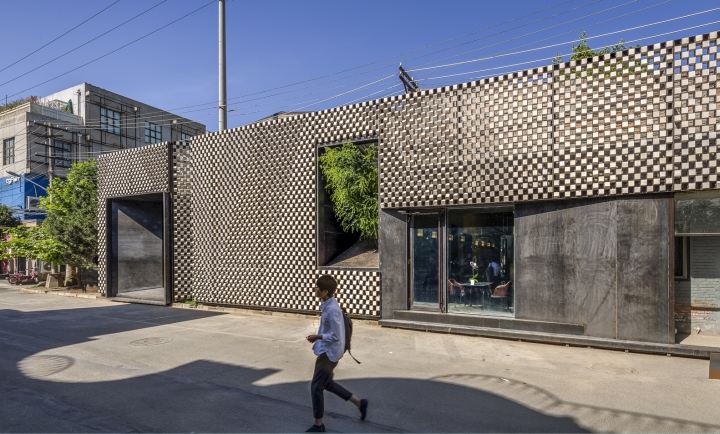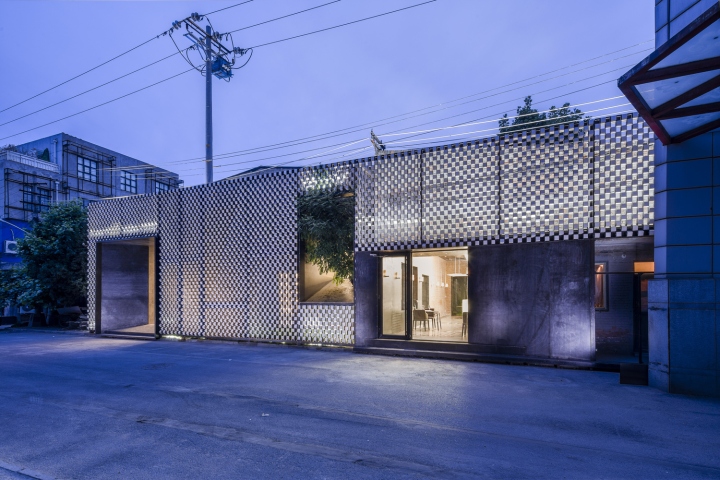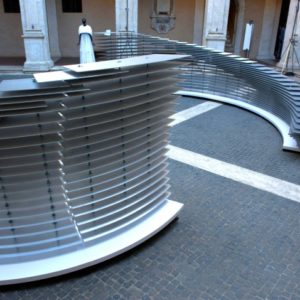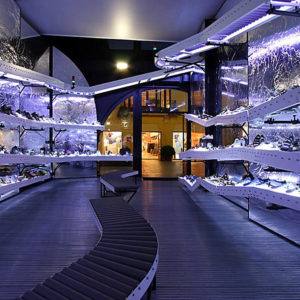


This rehabilitation project converts a storage space into a stone archive: to showcase the diversities of stone craft and to create a space for architects to contemplate their designs with stone. As the most primitive construction material, stone comes with dignity and authenticity. However, as construction becomes more and more visually dominated, stones are crafted to be light and polished. The spirit within stones seems to be lost, as stones are gradually substituted by other superficial materials. This project attempts to propose a critic for modern construction.

From rough to fine, stone processing begins with the moment when drill bits measure across the landscape and cut enormous cubical volumes of nature stones from the mountains. Our project departs from this notion by imagining the seven meter high storage space into a complete piece of stone. By dissecting the volume with angular plates, we create solid and void spaces: while solids are for exhibition, meeting and archive spaces, the voids become the circulation. The cutting plates are also materialized as different stone shelves for the separation and mediation between spaces.

Three layers of stone shelve walls array from exterior to interior to create a narration of stone processing in space. The stones used in the shelves are recycled materials from different stages of stone processing. The first layer that separates architecture from the street is a perforated stone wall made from thousands of 10cm stone cubes cut directly from left over dimension stones in the quarry.

The three trapezoidal openings punched through the perforated stone walls are the entrance, the clerestory window and the opening to the restaurant. Between the perforated and existing wall, there is a garden that brings light and breeze into the space. The second layer of stone shelves sets apart from the inside of existing wall and creates a residual space that prepares visitors for entering the gallery.

The outwards-tilted stone shelve in the second layer is composed by the stacking of mountain skins cut away from dimensional stones. The trace of chisel and the roughness of stone unveil the live of the material. The third layer of stone shelves is zigzag stone screen that separates exhibition space, meeting hall and stone archive within the double story gallery space. The stone screen is made of small flag stone slabs sliding between a structure net welded by steel. The space above and space below are connected and separated simultaneously by the stone screen.

As the material processing impacts the internal logic of architecture, architecture also becomes a reinterpretation of the material. By inventing new construction methods based upon levels of local craftsmanship, we strive to find coherence between the architecture scale and the detail scale of the work. We combine steel and stone construction in perforation, suspension and inclination to represent the authenticity of stone in a new way. Stone becomes the subject but also the background of the show.

Small restaurant, bar and cafe is placed next to the gallery. The catering space is enhanced by a library and an internal courtyard. The furniture and lighting of the space are designed with polished slabs and super thin complex stone veneers, which represents the finest degree of stone processing. A stone carpet made from parametrically arranged slabs brings the three spaces together.
Architects: Atelier Alter
Principals in Charge: Xiaojun Bu Yingfan Zhang
Design Team: Kai Qin, Zhenwei Li, Dehu Du, Tongwei Liu
Photographs: Courtesy of Atelier Alter















http://www.archdaily.com/789207/yingliang-stone-archive-atelier-alter





















Add to collection










